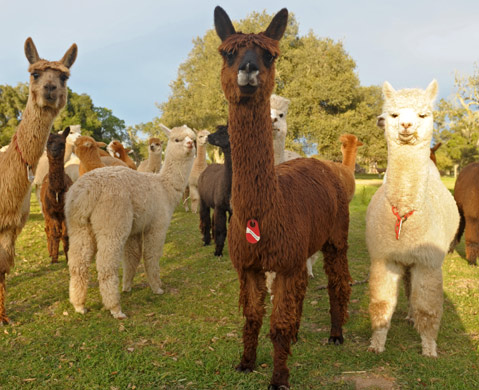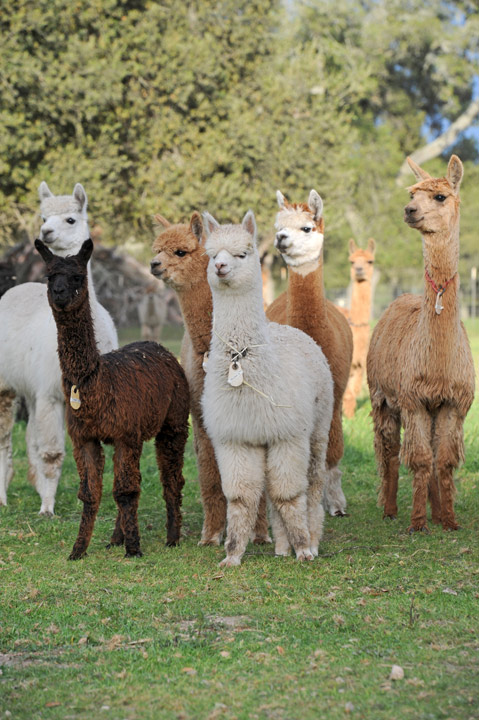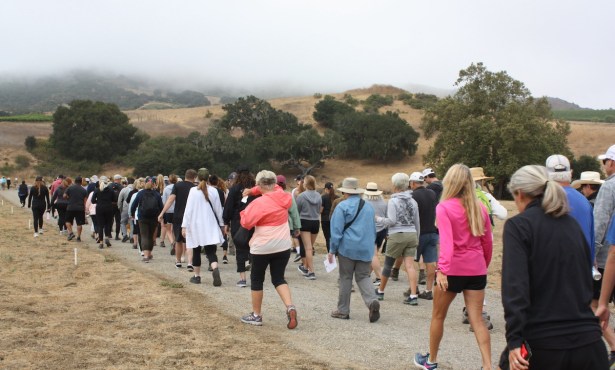The Hum of the (Not So) Wild
Alpacas Have Come Down from the Andes to Live and Thrive in Santa Barbara

He was 12 pounds of fluff dangling in my arms. Soft and silky, with big brown eyes, the baby alpaca (called a cria) was just one day old. The opportunity to hold the cute-as-a-button camelid came on a recent visit to Alpacas at West Ranch in the Santa Ynez Valley. Run by Hayley Jessup, the land has been home to alpacas since the late 1990s when Jessup acquired her first two.
Zaca Station Road, where the ranch is located, is a long way from their native South American Andes — specifically Peru, Ecuador, northern Chile, and northern Bolivia — where alpacas and their llama cousins graze at nose-bleed mountain altitudes of anywhere between 11,000 and 16,000 feet. Only about three feet tall at their withers, the long-domesticated alpaca is kept primarily for its luxurious fiber, although the animals are used for their meat and hides in some countries; their small stature prevents them from being proficient pack animals. Their migration from the mountaintops to the U.S. began in 1984, when the first of the fluffy four-leggeds were imported stateside. Now there are more than 50,000 alpacas in the country, with California being among the states with the largest populations.

It’s easy to see why Jessup is entranced by these creatures. “Alpacas’ natural state is relaxed. They are quiet and peaceful,” she said. “The only sound they make is humming.” They are calm, gentle, gorgeous, and funny, if unintentionally so. During my visit to West Ranch, a group of them would pad up, stand perfectly still, and in unison look quizzically at me, like a troop of soft-hooved meerkats at attention.
“Alpacas are one of God’s greatest creatures,” Jessup declared. They are not only politely quiet but also tidy in that they designate an area for pooping and so leave the majority of the farm waste- and odor-free. “If you had 100 horses or cows, the smell and impact [environmentally] is different. I could manage 100 alpacas all by myself,” she said.
The West Ranch denizens, of which there are more than 100, live on 40 acres spotted with oak trees and grazing pastures. It’s a full-service breeding, boarding, and sales facility, according to its literature. The alpacas, many of which come from championship bloodlines, also produce luxurious fiber that is then made into yarn for textiles (i.e., sweaters, coats, rugs, etc.). There are two kinds of alpacas — suri and huacaya, of which Jessup has both. You can tell them apart by their wool: Suris have long, ropy locks that are silky smooth; huacayas’ fleece is short, dense, and woolly, giving them a poofy look. They come in rich browns, cool whites, and sleek blacks, as well as grays, tans, and combinations of these hues. There are 52 classified natural alpaca colors in South America, nearly 20 natural in the U.S.
Jessup also keeps five llamas on the ranch, all of which were getting shorn during my visit. Because they don’t like their heads or legs to be touched, many came away with funny haircuts, often resembling mop-top versions of show poodles. Despite their appearance, the llamas, which are bigger and more inclined to spit (alpacas rarely sling slobber at humans), rule over their petite kin.
The day I visited was something out of All Creatures Great and Small. Patric Earnest and his assistant James Fairfield were de-frocking the llamas; Kathryn Bowers and Dr. Barbara Natterson-Horowitz, authors of the groundbreaking book Zoobiquity: The Astonishing Connection Between Human and Animal Health, were having a peek at the cria (research for their next book, perhaps); and Los Alamos–based vet David Jensen tended to the cria, giving him shots and taking some blood, before lancing a softball-sized cyst on the underside of another herd member’s jaw.
While the ranch folks took care of business, I happily handfed pellets to several alpacas and petted their soft muzzles. Hummm.
4•1•1
For more information or to schedule a visit to Alpacas at West Ranch, email Hayley Jessup at hayleyjessup@gmail.com or visit alpacasatwestranch.com.



